Kate Wells: Fragments of splendour
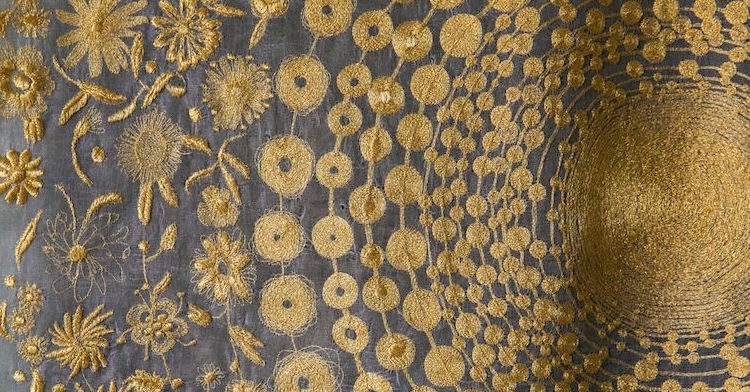
Kate Wells has been an exhibiting artist for 30 years combining teaching with studio work and family life. Her work has been included in group exhibitions worldwide and is in private and public collections. Curating and running the Textiles Section at Art in Action has been an important role in recent years.
In this interview, Kate tells us about the techniques and materials she uses to produce her breathtaking landscapes. We discover how being part of an art group helped introduce her to exhibiting and what direction her work will take in the future.
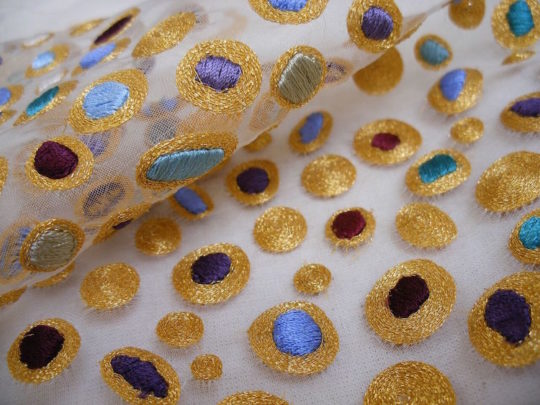
Kate Wells, Gold cabuchons sample, 2014, gold and rayon machine embroidery on silk crepeline
Holding things together
TextileArtist.org: What initially attracted you to textiles as a medium?
Kate Wells: I suppose it was the availability and familiarity of the medium, simply at hand. From the beginning, it looked as though it ticked all the boxes of making, shaping, infinite ways of changing and suggesting most subjects.
At Loughborough, I also used sculpture…chopping and hammering was probably my way of escaping the quiet, control of embroidery!
And, more specifically, how was your imagination captured by stitch?
Stitch itself took a lot longer to establish. As a way of holding things together, it was a natural methodology but it took the influence of Glasgow School of Art to make the link to drawing and then, much later, to find my own language with stitch.
I’ve always loved fine drawing and subtle colours so my relationship with stitch was with fine threads and fine details.
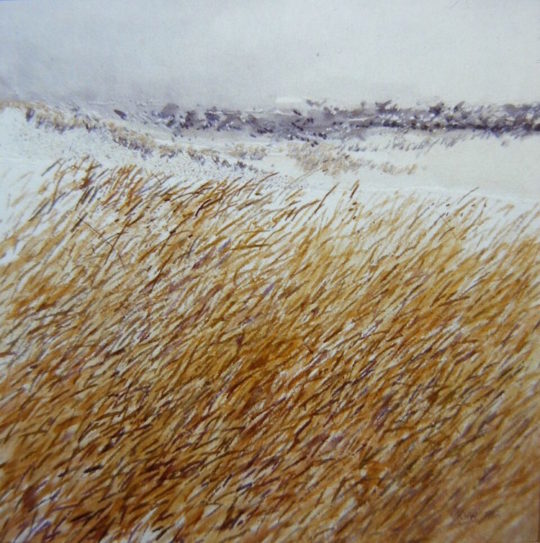
Kate Wells, A High Place, 1990, 90 x 90cm, paint on calico with hand and machine embroidery
What or who were your early influences and how has your upbringing influenced your work?
My family was a making crowd, always a project on the go. One of my earliest memories was of turning the wooden handle of my Mother’s black and gold Singer sewing machine while she mended sheets or made my dresses. She used to make a doll’s version of my own summer frocks.
My Grandmother was a bookbinder and knew tailoring. Along with my aunt, she made my coats, smocked dresses and beautiful stuffed toy dolls and creatures. I used to love searching out fabrics in the market and remember the joy of touching cloth, the smell of new material and of the crisp tissue paper of dress patterns. We always made or own clothes with or without a pattern.
I still have a hoarding problem with fabrics, I can’t throw stuff away, it might come in useful.
My daughters have picked up the making skills even better. Roanna went to MMU and studied Embroidery, Bethany is a theatre designer after Architecture at the RCA.
Big cities, bold experiments
What was your route to becoming an artist?
My art teacher at grammar school wasn’t encouraging! He was a brilliant teacher and I have two pieces of his own work which I bought after he died…he was inspirational but he was very old school and told me “that nice girls don’t go to art college”.
Being a nice girl I reluctantly chose teacher training and left after the first year but not before getting the lure of making with textiles. Art College Foundation was another world; I felt at home and knew that I’d be searching out the next stage with a needle and thread.
The Degree Course in Embroidery at Loughborough was followed by MA Textiles at Manchester Polytechnic (MMU) then followed by teaching on the Embroidered and Woven Textiles Degree Course at Glasgow School of Art. Manchester and Glasgow particularly opened my mind to exciting new possibilities, big cities, bold experiments.
Being accepted into the 62Group was the first step up into exhibiting. Textiles was bravely emerging into the field and we shared some exciting programmes and ventures at home and on the international stage.
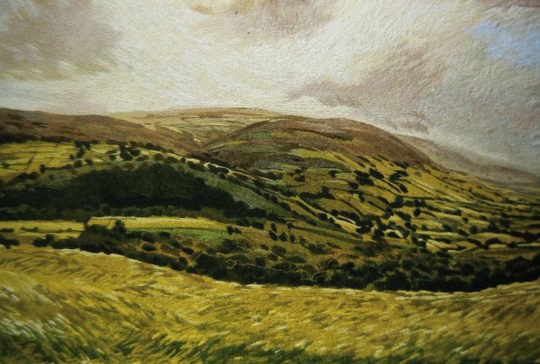
Kate Wells, Derbyshire Landscape, 2000, 100 x 75cm, machine embroidery
Tell us a bit about your chosen techniques.
Drawing, using charcoal, pen and ink, brush, pastel has always been an important part of my practice. I find observational drawing, tonal work especially focuses the mind and I’m drawn to landscape, flowers, birds.
Living in the country we are surrounded by hills and fresh air. It comes into my work naturally.
The Industrial Irish is my favourite tool. I love its wide stitch and freedom of expansion/contraction. It really is like drawing with a needle. The Irish also has space for a bigger frame or hoop so it’s a bigger view of the work as you make it.
I’m now exploring new work in gold threads on dissolvable fabrics and fine silk.
How do you use these techniques in conjunction with embroidery?
For many years I created machine embroidered landscapes on my beloved Irish, translating my drawings literally and using hundreds of subtle colours, building up a huge collection of machine sewing threads. These were often large-scale pieces combining painted areas with stitched, then finally totally stitched. Rather like weaving a tapestry, these works were slow and I was limited to how much I could produce.
So I resolved to go back to black and white using ink and collage, torn paper and texture in experimental paperwork. This liberated my lines and brought me back to basics, including hand stitching.
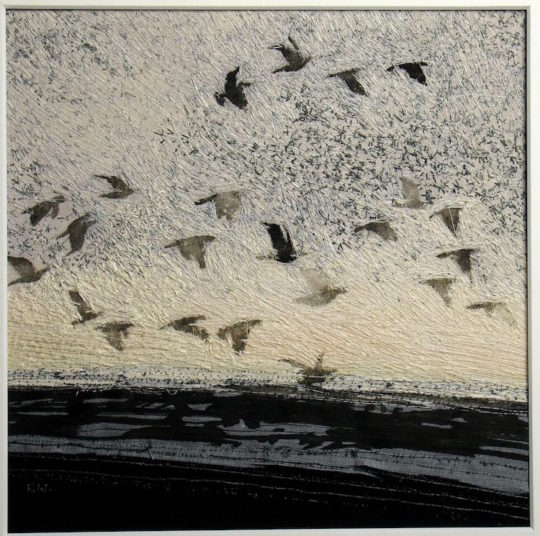
Kate Wells, Early Rise, 2013, 20 x 20cm, ink on calico with machine embroidery and collage
At the same time, I began exploring inner ideas, free from picture-making. This has been the most exciting part of my career, sampling and interpreting feelings and texts.
How would you describe your work and where do you think it fits within the sphere of contemporary art?
I’m comfortable to feel rooted in traditions. My work increasingly searches within for meaning. In a perilous and changing world, art can explore the unchanging.
Do you use a sketchbook? If not, what preparatory work do you do?
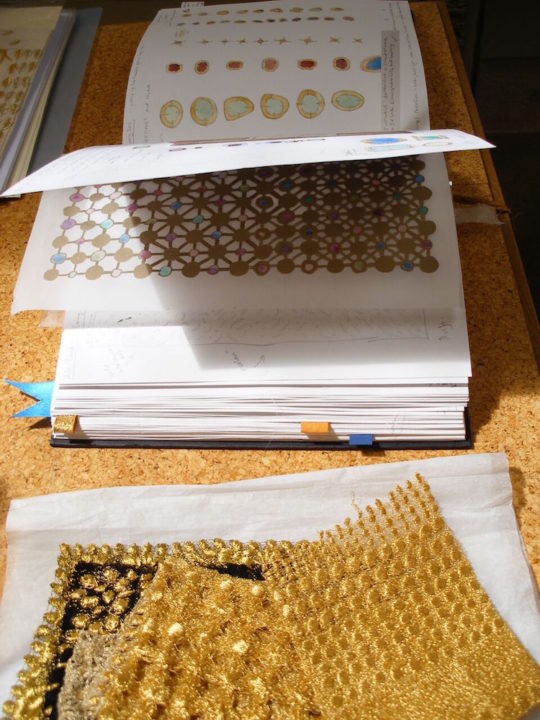
Kate Wells, Sketchbook and gold samples, 2016
I love my sketchbooks! They are personal diaries, often packed with samples and extra pages of sketches and found images. They have to be good quality paper, I now only use really heavy cartridge paper, bound black books, from Seawhite of Brighton, but have a shelf full of bulging ring binders for teaching samples and inspirations. I keep separate sketchbooks for landscape themes and gold and decorative ideas.
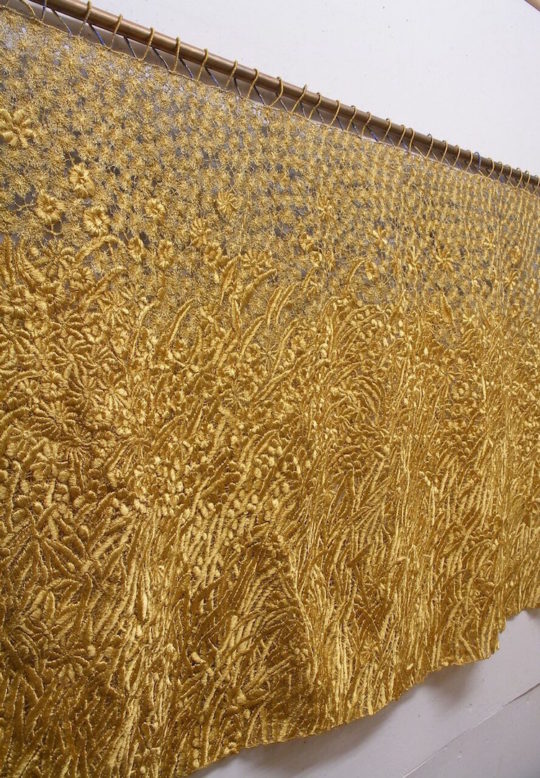
Kate Wells, Field of Gold, 2016, 162 x 61cm, gold machine embroidery dissolvable fabric
Solitude and silence
What environment do you like to work in?
I always envied artists with rented studios simply because they could go out to work but I needed to combine family life with art so we built some lovely workrooms at the back of our 17thC farmhouse.
My studio is high-roofed, has good natural light and doors opening onto the garden. I love this room and I like solitude and silence. I like to have several pieces on the go and move between them. I can go into this space in the evening, any time that’s available.
What currently inspires you?
Whilst caring for my elderly mother, I’ve decided to work through long-standing commissions and am now immersed in landscape again, loving a fresh approach. I’ve no idea how it will finally develop.
I’ve also started Zen calligraphy which is loosening up my brushwork, going really big and wet.
Who have been your major influences and why?
Post graduate studies in Manchester made a big impression on my approach to embroidery. Judy Barry took me into the machine room and introduced me to the Irish and Cornelli machines. She was totally inspiring, technically and imaginatively.
Anne Morrell introduced me to the team at Glasgow School of Art and my first task up there was to set up a machine room, fixing an old Irish and Cornelli! There I worked alongside Hannah Frew-Paterson and Crissie White under the historical influence of Kathleen White, you could feel her presence in the walls! In Glasgow, the real connection with drawing and stitch fell into place.
Art in Action has been an influence throughout my whole career. The event brought hundreds of amazing artists together and each year we worked alongside one another. It has been a living community of sharing and inspiration for 40 years.
Diana Springall has also been at the heart of my bigger picture of embroidery – becoming a dear friend, to many, and collecting emerging artists’ work to form the wonderful Diana Springall Collection.
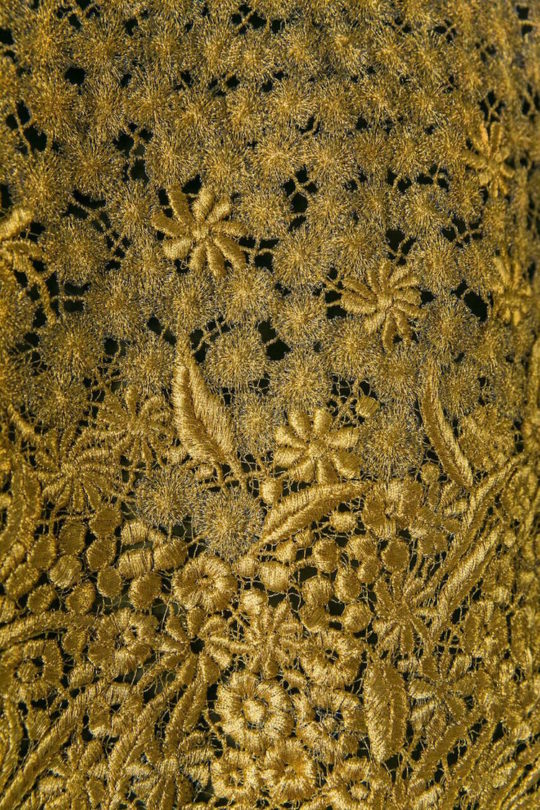
Kate Wells, Field of Gold (detail), 2016, 162 x 61cm, gold machine embroidery dissolvable fabric
A significant shift
Tell us about a piece of your work that holds particularly fond memories and why?
A commission from a visitor to Art in Action sent me to North Yorkshire to draw the hills and then embroider a large hanging. Sitting alone surrounded by the moors, sheep, birdsong and huge sky was very special and the personal friendship between client and artist grew from the love we both felt for that place.
How has your work developed since you began and how do you see it evolving in the future?
In many ways, the work is recognisable throughout my career as there’s a signature of composition and fine detail. A significant shift took place in the last 5 years with a turn to look within for inspiration leading me to trust other resources. I also started using gold thread and dissolvable fabric to make lace – ‘fragments of splendour’ – and a large, circular embroidery on fine silk
A significant shift took place in the last 5 years with a turn to look within for inspiration leading me to trust other resources, I also started using gold thread and dissolvable fabric to make lace – fragments of splendour – and a large, circular embroidery on fine silk crepeline based on meditation, ‘Dip Your Mind in Gold’.
Being an artist is not in isolation and often my own aspirations seem unimportant when the people around me need caring and support. It often feels like a tension but usually, space re-appears and the work continues.
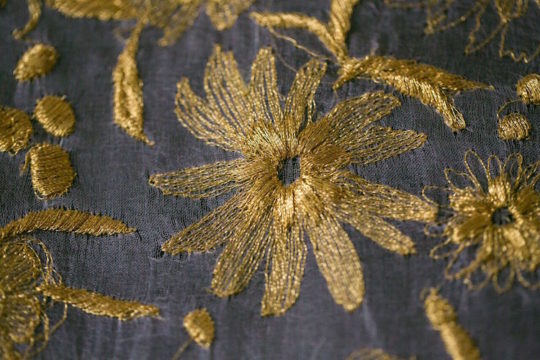
Kate Wells, Dip Your Mind in Gold (detail), 2015, gold machine embroidery on silk crepeline
What advice would you give to an aspiring textile artist?
Be open to possibilities at first, learn as many skills as you can and then recognise your own inner voice. It’s so easy to be over-influenced by the amazing work that others produce and post on social media. Comparison can be a killer. You have to trust yourself and love your chosen line of inspirations.
I’m grateful for the lean periods in life too. They can be valuable times for reflection and expansion. New routes come out of the unexpected.
What piece of equipment or tool could you not live without?
My Irish machine is my most treasured piece of equipment. It’s from the 1930’s and it purrs. I also love my Lowery workstand for holding frames when hand stitching. It’s a neat and simple product.
Do you give talks or run workshops or classes? If so where can readers find information about these?
I enjoy giving talks to groups, Embroiderer’s Guild or independent textile groups. My diary is up on my website.
How do you go about choosing where to show your work?
I’ve always found Art in Action to be a brilliant showcase and will miss it for the next generation artists.
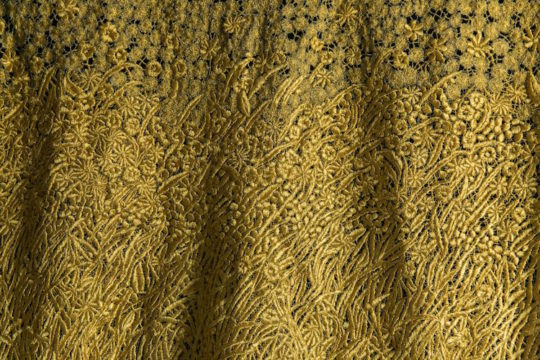
Kate Wells, Field of Gold (detail), 2016, 162 x 61cm, gold machine embroidery dissolvable fabric
For more information visit: www.katewellsartist.co.uk
Got something to say about the techniques, materials and processes used by this artist – let us know by leaving a comment below.
















Wonderful article! Thank you
Thank for such a fantastic write up about Kate Ewells
Thank you! Beautiful article with beautiful illustrations!
Thanks so much, Kate for the interesting account of your journey!
Enjoyed reading the interview and was delighted to learn of your time at the Glasgow School of Art. I studied under Kathleen White and was a fellow classmate of Hannah Frew. Magical times.
Thank you for sharing your obvious enthusiasms and joy in creating. It sounds like a good journey so I hope it continues well. Incidentally I’d never heard of an ‘industrial Irish’ before – what are they like?
I also have not heard of ‘industrial Irish ‘. Can you please explain?
Fabulous article Kate, lovely to see your work here, always so inspirational
Very good information.logically useful.if you need help related to Facebook contact (407) 965-2136 or visit http://www.faceboookhelp.us
I love your work so it’s great to hear more about your process. Thanks too for the Lowery workstand info! I’ve been wanting to find one for a long time.
Deeevine work!!
Wow also saw all the work on your website and more wow. And apart from your beautiful ‘stitched works’ you works on paper are gorgeous. Thank you